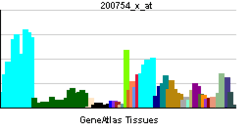SFRS2
Splicing factor, arginine/serine-rich 2 is a protein that in humans is encoded by the SFRS2 gene.[1][2][3]
Interactions
SFRS2 has been shown to interact with CDC5L[4] and ASF/SF2.[5]
References
- ↑ Bermingham JR Jr, Arden KC, Naumova AK, Sapienza C, Viars CS, Fu XD, Khotz J, Manley JL, Rosenfeld MG (February 1996). "Chromosomal localization of mouse and human genes encoding the splicing factors ASF/SF2 (SFRS1) and SC-35 (SFRS2)". Genomics 29 (1): 70–9. doi:10.1006/geno.1995.1216. PMID 8530103.
- ↑ Fu XD, Maniatis T (May 1992). "Isolation of a complementary DNA that encodes the mammalian splicing factor SC35". Science 256 (5056): 535–8. doi:10.1126/science.1373910. PMID 1373910.
- ↑ "Entrez Gene: SFRS2 splicing factor, arginine/serine-rich 2".
- ↑ Ajuh, P; Kuster B; Panov K; Zomerdijk J C; Mann M; Lamond A I (December 2000). "Functional analysis of the human CDC5L complex and identification of its components by mass spectrometry". EMBO J. (ENGLAND) 19 (23): 6569–81. doi:10.1093/emboj/19.23.6569. ISSN 0261-4189. PMC 305846. PMID 11101529.
- ↑ Zhang, W J; Wu J Y (October 1996). "Functional properties of p54, a novel SR protein active in constitutive and alternative splicing". Mol. Cell. Biol. (UNITED STATES) 16 (10): 5400–8. ISSN 0270-7306. PMC 231539. PMID 8816452.
Further reading
- Sureau A; Soret J; Vellard M et al. (1993). "The PR264/c-myb connection: expression of a splicing factor modulated by a nuclear protooncogene". Proc. Natl. Acad. Sci. U.S.A. 89 (24): 11683–7. doi:10.1073/pnas.89.24.11683. PMC 50620. PMID 1465383.
- Vellard M; Sureau A; Soret J et al. (1992). "A potential splicing factor is encoded by the opposite strand of the trans-spliced c-myb exon". Proc. Natl. Acad. Sci. U.S.A. 89 (7): 2511–5. doi:10.1073/pnas.89.7.2511. PMC 48691. PMID 1557353.
- Zahler AM, Lane WS, Stolk JA, Roth MB (1992). "SR proteins: a conserved family of pre-mRNA splicing factors". Genes Dev. 6 (5): 837–47. doi:10.1101/gad.6.5.837. PMID 1577277.
- DuBridge RB; Tang P; Hsia HC et al. (1987). "Analysis of mutation in human cells by using an Epstein-Barr virus shuttle system". Mol. Cell. Biol. 7 (1): 379–87. PMC 365079. PMID 3031469.
- Tacke R, Manley JL (1995). "The human splicing factors ASF/SF2 and SC35 possess distinct, functionally significant RNA binding specificities". EMBO J. 14 (14): 3540–51. PMC 394422. PMID 7543047.
- Luznik L; Martone ME; Kraus G et al. (1995). "Localization of human immunodeficiency virus Rev in transfected and virus-infected cells". AIDS Res. Hum. Retroviruses 11 (7): 795–804. doi:10.1089/aid.1995.11.795. PMID 7546906.
- Maruyama K, Sugano S (1994). "Oligo-capping: a simple method to replace the cap structure of eukaryotic mRNAs with oligoribonucleotides". Gene 138 (1–2): 171–4. doi:10.1016/0378-1119(94)90802-8. PMID 8125298.
- Kohtz JD; Jamison SF; Will CL et al. (1994). "Protein-protein interactions and 5'-splice-site recognition in mammalian mRNA precursors". Nature 368 (6467): 119–24. doi:10.1038/368119a0. PMID 8139654.
- Wu JY, Maniatis T (1994). "Specific interactions between proteins implicated in splice site selection and regulated alternative splicing". Cell 75 (6): 1061–70. doi:10.1016/0092-8674(93)90316-I. PMID 8261509.
- Sureau A, Perbal B (1994). "Several mRNAs with variable 3' untranslated regions and different stability encode the human PR264/SC35 splicing factor". Proc. Natl. Acad. Sci. U.S.A. 91 (3): 932–6. doi:10.1073/pnas.91.3.932. PMC 521427. PMID 8302870.
- Fu XD (1993). "Specific commitment of different pre-mRNAs to splicing by single SR proteins". Nature 365 (6441): 82–5. doi:10.1038/365082a0. PMID 8361546.
- Zhang WJ, Wu JY (1996). "Functional properties of p54, a novel SR protein active in constitutive and alternative splicing". Mol. Cell. Biol. 16 (10): 5400–8. PMC 231539. PMID 8816452.
- Tronchère H, Wang J, Fu XD (1997). "A protein related to splicing factor U2AF35 that interacts with U2AF65 and SR proteins in splicing of pre-mRNA". Nature 388 (6640): 397–400. doi:10.1038/41137. PMID 9237760.
- Sureau A; Soret J; Guyon C et al. (1998). "Characterization of multiple alternative RNAs resulting from antisense transcription of the PR264/SC35 splicing factor gene". Nucleic Acids Res. 25 (22): 4513–22. doi:10.1093/nar/25.22.4513. PMC 147067. PMID 9358160.
- Suzuki Y; Yoshitomo-Nakagawa K; Maruyama K et al. (1997). "Construction and characterization of a full length-enriched and a 5'-end-enriched cDNA library". Gene 200 (1–2): 149–56. doi:10.1016/S0378-1119(97)00411-3. PMID 9373149.
- Zhang WJ, Wu JY (1998). "Sip1, a Novel RS Domain-Containing Protein Essential for Pre-mRNA Splicing". Mol. Cell. Biol. 18 (2): 676–84. PMC 108778. PMID 9447963.
- Imai Y; Matsuo N; Ogawa S et al. (1998). "Cloning of a gene, YT521, for a novel RNA splicing-related protein induced by hypoxia/reoxygenation". Brain Res. Mol. Brain Res. 53 (1–2): 33–40. doi:10.1016/S0169-328X(97)00262-3. PMID 9473574.
- Parfenov VN; Davis DS; Pochukalina GN et al. (1998). "Dynamics of distribution of splicing components relative to the transcriptional state of human oocytes from antral follicles". J. Cell. Biochem. 69 (1): 72–80. doi:10.1002/(SICI)1097-4644(19980401)69:1<72::AID-JCB8>3.0.CO;2-S. PMID 9513048.


